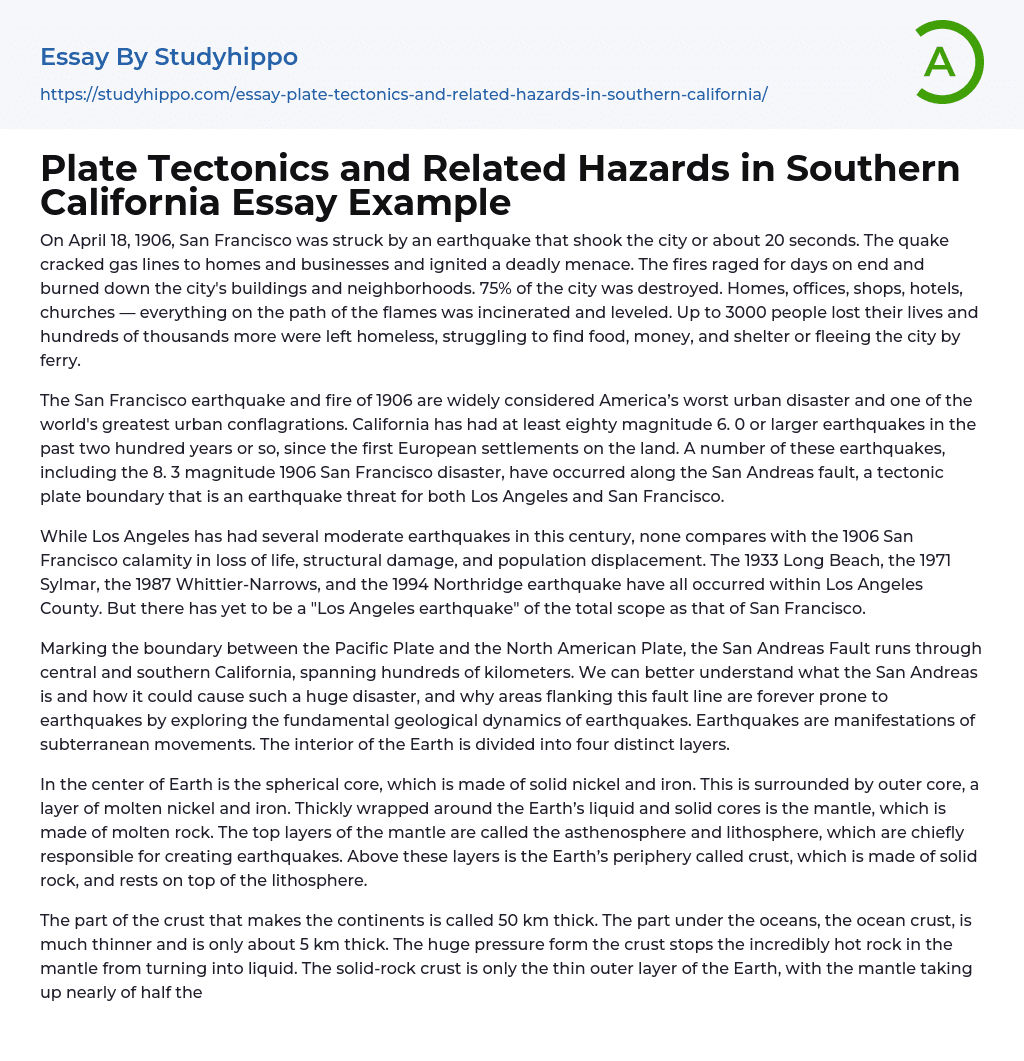

Plate Tectonics and Related Hazards in Southern California Essay Example
On April 18, 1906, San Francisco was struck by an earthquake that shook the city or about 20 seconds. The quake cracked gas lines to homes and businesses and ignited a deadly menace. The fires raged for days on end and burned down the city's buildings and neighborhoods. 75% of the city was destroyed. Homes, offices, shops, hotels, churches — everything on the path of the flames was incinerated and leveled. Up to 3000 people lost their lives and hundreds of thousands more were left homeless, struggling to find food, money, and shelter or fleeing the city by ferry.
The San Francisco earthquake and fire of 1906 are widely considered America’s worst urban disaster and one of the world's greatest urban conflagrations. California has had at least eighty magnitude 6. 0 or larger earthquakes in the past two hundred years or so, since the
...first European settlements on the land. A number of these earthquakes, including the 8. 3 magnitude 1906 San Francisco disaster, have occurred along the San Andreas fault, a tectonic plate boundary that is an earthquake threat for both Los Angeles and San Francisco.
While Los Angeles has had several moderate earthquakes in this century, none compares with the 1906 San Francisco calamity in loss of life, structural damage, and population displacement. The 1933 Long Beach, the 1971 Sylmar, the 1987 Whittier-Narrows, and the 1994 Northridge earthquake have all occurred within Los Angeles County. But there has yet to be a "Los Angeles earthquake" of the total scope as that of San Francisco.
Marking the boundary between the Pacific Plate and the North American Plate, the San Andreas Fault runs through central and southern California
spanning hundreds of kilometers. We can better understand what the San Andreas is and how it could cause such a huge disaster, and why areas flanking this fault line are forever prone to earthquakes by exploring the fundamental geological dynamics of earthquakes. Earthquakes are manifestations of subterranean movements. The interior of the Earth is divided into four distinct layers.
In the center of Earth is the spherical core, which is made of solid nickel and iron. This is surrounded by outer core, a layer of molten nickel and iron. Thickly wrapped around the Earth’s liquid and solid cores is the mantle, which is made of molten rock. The top layers of the mantle are called the asthenosphere and lithosphere, which are chiefly responsible for creating earthquakes. Above these layers is the Earth’s periphery called crust, which is made of solid rock, and rests on top of the lithosphere.
The part of the crust that makes the continents is called 50 km thick. The part under the oceans, the ocean crust, is much thinner and is only about 5 km thick. The huge pressure form the crust stops the incredibly hot rock in the mantle from turning into liquid. The solid-rock crust is only the thin outer layer of the Earth, with the mantle taking up nearly of half the earth's radius and the outer and inner cores taking up about another half. Lithosphere, the outer rim of the mantle is about 100 km thick (geology. com 2006)). 4. billion years ago, the Earth was formed out of hot gases.
As the Earth cooled, the lithosphere cracked and split into seven large and twelve small floating pieces of puzzle,
with uneven and ragged edges. These huge pieces of crust and the upper part of the lithosphere are called tectonic plates, and continuously move over the viscous mantle rubbing and pushing against each other. These plates move at about the same speed as human fingernails grow. The tectonic plates have to move because of the slow swirling movements of semi-molten rock deep in the mantle.
Plate tectonics is the study of crunching, grinding and jostling and other dynamics of friction between the giant rocky plates under the Earth’s surface, on which are situated continents and oceans. The boundaries between two such massive, constantly moving tectonic plates are called faults. When the Earth's plates move against each other, the lithosphere absorbs much stress. However, when this stress accumulates up to a breaking point, the lithosphere breaks or shifts (Glasscoe).
An earthquake is caused by sudden, violent shifting of the tectonic plates which releases stress that accumulates along geologic faults. The areas lying in vicinity of the fault line are especially susceptible to earthquakes (although significant tremors can occur in relatively stable interior of continents). The San Andreas fault is a fracture appearing where the North American and the Pacific plates slide past each other. Passing through south California, it is perhaps the most well-known of faults, infamous for causing severe earthquakes.
- Alaska essays
- Boston essays
- Brazil essays
- California essays
- Canada essays
- Chicago essays
- Costa Rica essays
- Florida essays
- Hawaii essays
- Latin America essays
- Los Angeles essays
- Mexico essays
- Slavery In America essays
- Usa essays
- Virginia essays
- Washington essays
- Atmosphere essays
- Biodiversity essays
- Coral Reef essays
- Desert essays
- Earth essays
- Ecosystem essays
- Forest essays
- Lake essays
- Natural Environment essays
- Ocean essays
- Oxygen essays
- Rainbow essays
- Sea essays
- Soil essays
- Volcano essays
- Water essays
- Wind essays
- Agriculture essays
- Albert einstein essays
- Animals essays
- Archaeology essays
- Bear essays
- Biology essays
- Birds essays
- Butterfly essays
- Cat essays
- Charles Darwin essays
- Chemistry essays
- Dinosaur essays
- Discovery essays
- Dolphin essays
- Elephant essays
- Eli Whitney essays
- Environmental Science essays



